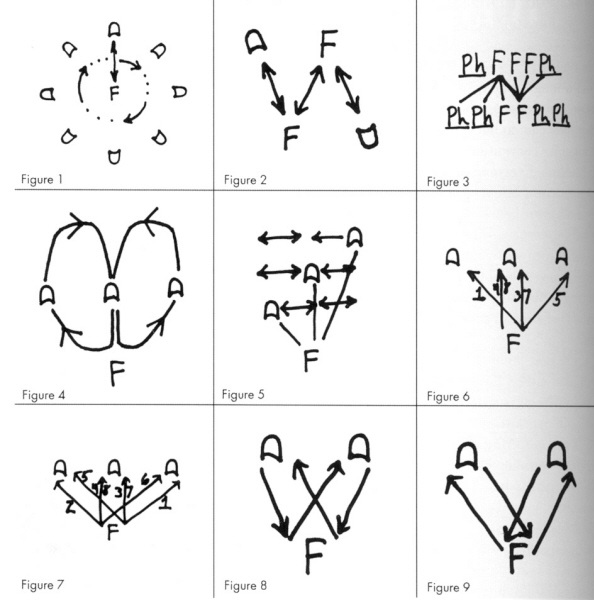 |
Page 28 Summer 1991
|
JUGGLER'S WORKSHOP FEEDS
Got two or more juggling partners? That's enough for a feed, but there's more than one way to feed a juggler. We'll describe some feeds that run the gamut from easy to much harder. THE
BASIC FEED As
you probably already know, a feed is a juggling pattern in which one
juggler - the feeder-is passing to two or more other jugglers -the
feedees.
The
simplest feed involves three jugglers, with the feeder passing to
the two feedees. Most often, the feeder passes a 2-ct (every right
hand); each feedee passes a 4-ct (every other right hand) and gets
half the feeder's passes. But a novice feeder can slow down to a
4-ct, in which case the feedees do an 8-ct (every fourth right
hand). That gives the feeder an easier job, but it may get boring
for the feedees, so you'll probably want to quickly work up to
having the feeder do a 2-ct. The feeder can even go to doing a 1-ct
or a different sort of rhythm such as in the 3-ct feed (we'll talk
about these later). LARGER
FEEDS A
feed can have any number of feedees. They just form a line
facing the feeder, who starts passing, say, to the feedee on the
feeder's far left. Then on each right-hand throw, the feeder
exchanges one pass with the next juggler down the line. Upon
reaching the end of the line the feeder reverses direction and heads
back up the line to the starting point, where the feed reverses
direction again, and so on.
For
the feeder, it's useful to keep glancing ahead to see just where the
next feedee is. This is particularly important in feeds where the
feeder has to turn or move noticeably to face the next feedee
(say, with more than about three feedees).
Ideally,
all the feedees should be the same distance from the feeder. With
only two feedees this is easy, but with bigger feeds, the line of
feedees should really be not straight but a circular arc, with the
feeder in the center of the circle. A
different and interesting way of having the feeder's throws
all be the same length is for the feeder to move along the line
and/or to have the feedees moving past the feeder.
THE
FEEDEES' JOB The
feedees should watch carefully to match the feeder's rhythm,
especially with more than two feedees where it's easier to get out
of sync. Each feedee should try to throw to the feeder exactly when
the feeder is passing. With a large feed, novice feedees tend to
juggle at their own speed instead of at the feeder's speed and thus
often pass at the wrong time, making the pattern less stable. The
feeder should be treated as the conductor of an orchestra and all
the feedees should follow the beat carefully. Being able to adjust
your juggling speed is crucial.
As
a feedee in a big feed, you should also watch the feeder so that you
know when it's your turn. A good way to do that is to be aware of
where the feeder is passing, especially as the feed gets close to
you. You know that your pass comes right after the pass to your
neighbor, so notice when the feeder and your neighbor exchange
passes. THE
TYPEWRITER FEED With
more than two feedees, the standard feed
cheats the two jugglers on the ends, as they get to pass only half
as many clubs as the feedees in the middle. One way to solve this
problem is to do a typewriter feed in which the feeder jumps back to
the extreme left quickly after passing to the last feeder on the
right (like a typewriter doing a carriage return, for those of you
who remember typewriters).
CIRCLE
FEEDS The
only difficulty with the typewriter feed comes from the possibly great
distance between the two end feedees and the amount of turning the
feeder has to do quickly to pass to the far left after passing to the
far right. You can eliminate this problem by having the feedees form a
circle around the feeder, who then just keeps turning to the right
(see Fig. 1). In a circle feed, the feeder should locate each new
feedee before passing.
It
takes about eight or more feedees in the circle to make the distance
between them not too unmanageable for the feeder (depending on the
feeder's experience level). Although eight feedees in a circle will be
doing only a 16-ct, each must pay close attention to the passing
rhythm and know when it's time to pass.
We
can make it more interesting by introducing more feeders in the
middle. For instance, with two feeders back to back, eight feedees can
do an 8-ct each, or with three feeders, nine feedees
can do a 6-ct. Such multiple feeders must work to stay in sync
since they can't see each other. A useful technique is simply
to have someone count the rhythm of the passes out loud. With
three or four feeders on the inside of the circle with their backs
together and a number of feedees on the outside, the feeders have to
move around the circle fairly quickly, trying not to bump into each
other. To make this easier and to make the pattern yet more
interesting, you can have the feedees moving slowly sideways around
the outside of the circle in the opposite direction. (With multiple
feeders, the feedees are actually feeding
too and the distinction between feeders and feedees dissolves.) |
 |